Cherry leaves turn yellow in July: what to do and why this happens
The gardening season is already open, and soon summer residents will be harvesting large and juicy cherries. The berries are used to bake pies and make jams, prepare desserts, or simply freeze the fruits in the freezer. To ensure that the cherry tree is productive, gardeners pay attention to caring for it. Cherries are moisture-loving and require constant fertilization. A healthy tree should have dark green leaves. If their color changes, this indicates problems. Why cherry leaves turn yellow in July and what to do about it, we will consider further.
Reasons for yellowing of cherry leaves in June
There are many reasons why cherry leaves turn yellow in June: deficiency of microelements in the soil, errors in planting and care, diseases and insect pests. Sometimes yellowing occurs for one reason, sometimes it affects several at once. For example, a cherry tree lacks light and nutrition, and because of this, it developed coccomycosis.
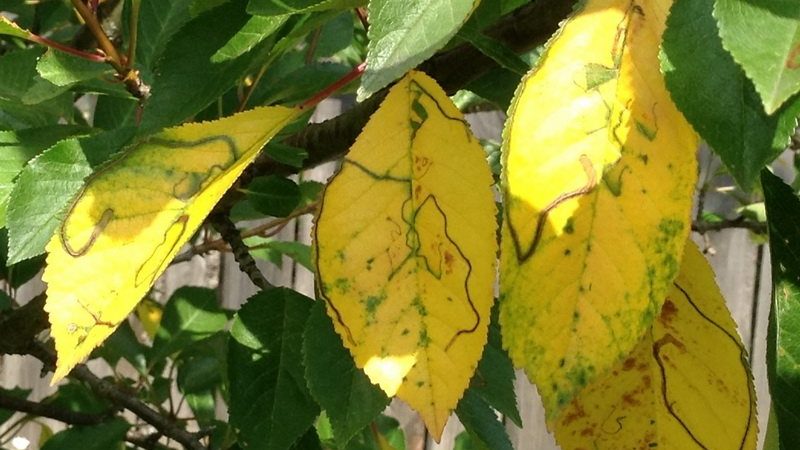
Nutritional deficiencies
Cherries receive their nutrition from fertilizers that are applied throughout the growing season. If you do not follow the dosage or forget about feeding, there will be a deficiency of microelements. This entails weak immunity, developmental delays, yellowing of leaves and drying of shoots.
Signs of a lack of certain substances:
- lack of nitrogen manifests itself in the fact that the leaves grow small and have a weak green or yellowish color;
- phosphorus starvation is easily recognized by short and dry shoots, narrow leaves, and changes in their color;
- with potassium deficiency, the leaves acquire a bluish tint, some are covered with yellow-brown dots;
- lack of calcium is accompanied by the death of young leaves;
- lack of boron manifests itself in the form of chlorosis of young leaves - the veins turn yellow, the leaves curl and become smaller;
- With a lack of zinc, the shoots become brittle and brittle, and the color of the leaf plates changes.
Diseases
The first signs of diseases are difficult to identify; gardeners usually notice problems when the leaves have already turned yellow or changed shape. There is no variety that is completely protected from diseases, so it is recommended to regularly inspect cherries for changes.
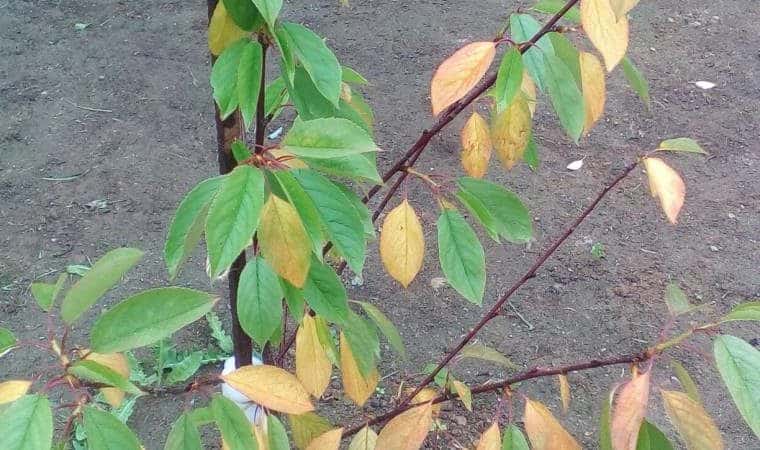
Coccomycosis
The fungal disease is common in central Russia and affects young and mature trees. It spreads quickly and affects cherries in orchards and plantations. The first sign of coccomycosis is reddish or brownish-brown small spots on the leaves. Over time, they merge and turn into one large spot.
The chlorophyll content in the trees is halved, so the cherry loses its ability to retain moisture. Because of this, the leaves turn yellow and fall off already in July or August. A bare tree's immunity weakens, biological processes are disrupted, and it will not be prepared for winter.
Moniliosis
Moniliosis (fruit rot) is common in regions with damp and cool springs. The causative agent of the disease, a fungus, infects plants during the flowering period. It enters through the bark and spreads throughout the tree.
Reference. Pathogenic fungi are frost-resistant, so they overwinter in the soil and, with the arrival of spring, infect healthy plants.
Gardeners notice wilting flowers, yellowing and drying of foliage.The fruits become deformed, become soft, and become covered with small creamy pads. Moniliosis carriers are diseased neighboring plants, wind, rain, insects. The disease actively develops at temperatures up to +20°C and air humidity of 95–100%.
Scab
Scab does not harm the tree, but the crop. The fungus overwinters in the foliage and appears on the plant in April–May. The leaves become covered with bright yellow spots, which darken and crack over time. The spread of scab is facilitated by high humidity, lack of sunlight, and dense plantings. The disease is difficult to combat, as it occurs during the flowering period, when cherries cannot be sprayed with chemicals.
Pests
The cherry tree crumbles and sheds its leaves due to damage from insect pests. They overwinter in plant debris; most insects live in colonies. Some are capable of destroying the entire crop.
Cherry aphid
A small insect sucks the juice from the plant. The length of black aphids is 2 mm, so it is difficult to notice them on the site. Only the dark color helps to distinguish the insect. They look for the pest at the tips of branches; it loves young shoots. Aphids lay eggs for the winter, and larvae appear on cherries in the spring. The tree shoots curl, the leaves dry out and become deformed.
Aphids are especially active in June–July, when the weather is hot. Adults live in grass and fallen leaves. Pests multiply very quickly, so if they are detected, it is recommended to immediately take remedial measures.
Slimy sawfly
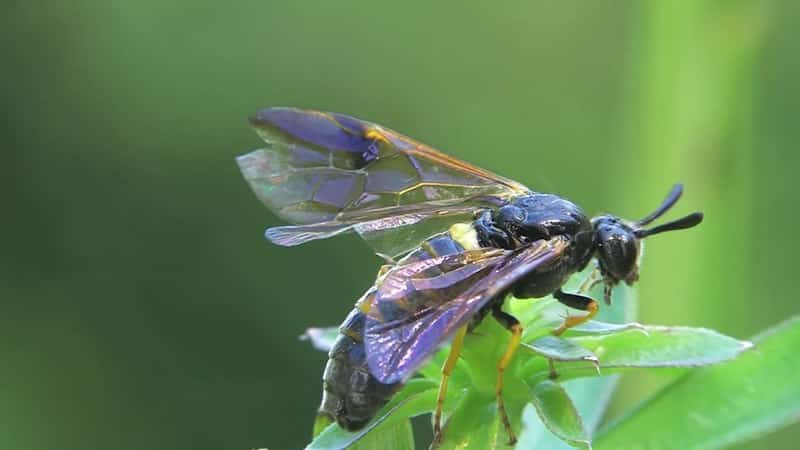
The cherry slimy sawfly lives off the sap of the plant. The length of the insect is 4–6 mm, the color is black or brown. The sawfly appears in the garden in late May - early June. Damages the leaves, causing the plant to weaken and wither.Weeds, acidic and poor soil, improper care, and sudden changes in weather contribute to the development of pests.
Cherry moth
Caterpillars and adults pose a danger to cherries. The larvae overwinter in cracks in the bark, and with the arrival of spring they appear outside. The caterpillars penetrate the fruit buds and eat young leaves and flowers. Leaves that remain untouched turn yellow and dry out over time.
This is interesting:
How to properly plant cherries in the fall: instructions for a novice gardener
What are good cherry-cherry hybrids and what are their features?
Agrotechnical errors
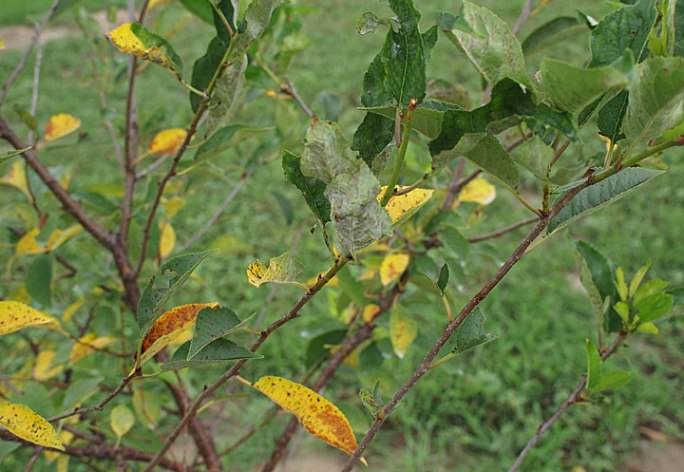
Both experienced gardeners and beginners make mistakes when growing. Caring for cherries consists of watering, fertilizing, loosening, mulching and pruning.
What mistakes do summer residents make most often:
- do not remove leaves, weeds and other plant debris near the plantings;
- plant cherries in acidic soil;
- water the plants irregularly;
- use cold water from the tap or from a spring for irrigation;
- do not maintain a distance between plants of less than 2 m;
- allow a deficiency or excess of microelements;
- use only organic or only mineral fertilizers;
- trim old shoots with dirty garden tools;
- carry out sanitary pruning less than once a year;
- do not mulch cherries with sawdust, straw, or hay;
- do not loosen the soil 2 times a month.
A common mistake many gardeners make is failure to comply with the timing of watering and fertilizing. Moisten the plant every 15 days, feed it 3-4 times per season. The amount of watering depends on the growing region.
How to save a tree
If the reason for the yellowness of the leaves lies in diseases or pests, the cherries are treated with chemicals. The drugs used are “Gamair”, “Kaptan”, “Chorus”, “Strobi”. They are effective against most fungi and other pathogens and are used for both therapeutic and preventive purposes.
If pests and diseases have destroyed entire shoots and leaves, the affected areas are removed and burned. The remaining ones are sprayed with mustard solution: 100 g of powder is dissolved in 10 liters of cool water. The procedure is carried out in the morning. The solution strengthens the cherry's immunity and helps it recover from illness or damage from insects.
If the main problem is insects, remove them by hand if possible, and then begin processing. This method is effective if the pest is discovered during the flowering period: at this time you should not resort to chemicals. If there is no time for manual cleaning, special trap tapes are used. Insects are washed off with water from a hose, and then the soil is watered with boiling water.
What to do if the leaves fall
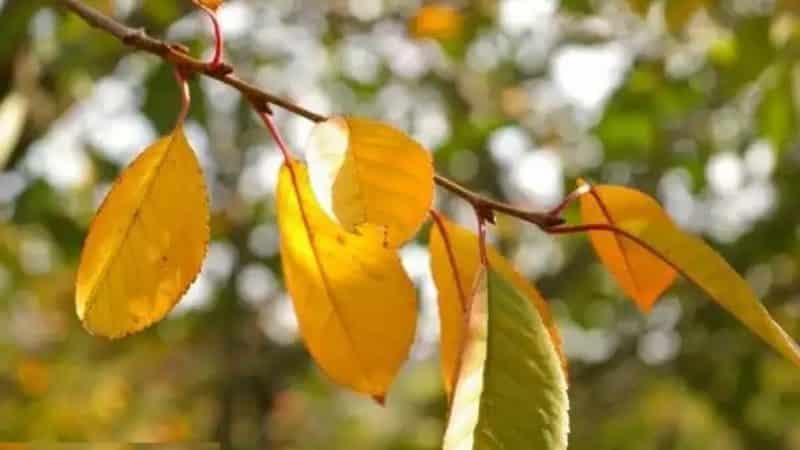
In this case, pruning will help save the tree. To do this, remove dry and bare branches, collect fallen leaves and weeds. Everything is put in one pile and burned away from the garden plot. Experienced summer residents urge not to be afraid of such drastic measures: it is better to remove several diseased and weak branches than to lose an entire cherry tree in a year.
Attention! To protect the cherry from falling leaves next year, ammophoska is applied before winter: make a groove, fill it at the rate of 30 g per 1 m². Sprinkle the base with dry ash. Such activities will strengthen the plant’s immunity.
After pruning, the plant is weakened, so it is fed with complex fertilizers. They contain nitrogen, potassium, phosphorus, calcium, zinc, copper, iron, boron.The preparations “Magic Leika”, “Kemira”, “Gumi-Omi” are used for fruit and berry trees. Before the procedure, the soil is loosened and watered abundantly with warm water.
Preventive measures
It is impossible to grow a rich cherry harvest without preventive measures. They protect the plant from diseases and insects and make the plant resistant to external influences.
Gardeners recommend:
- carry out pruning in dry weather, watering in calm and cloudy weather;
- inspect regularly landings;
- buy varieties, suitable for a specific growing region;
- plant cherries away from apple and pear trees;
- after pruning, treat wounds with garden varnish;
- apply water at the root, bypassing leaves, fruits and shoots;
- in the fall, dig up the soil and remove all debris;
- Use disinfected garden tools for work.
Advice from experienced gardeners

To ensure a productive and fruitful summer, experienced gardeners recommend spraying cherries with folk remedies. They do not require financial investment, are easy to prepare and are good for plants.
Attention! Before starting to treat with chemicals, it is recommended to spray only one branch and see the plant’s reaction. If there are no side effects, the entire tree is treated.
To prepare the infusion, you need tops, stems and leaves of dandelion, nettle, and chamomile. The raw materials are poured with boiling water at a ratio of 1:1. Leave for 2 days and use for processing.
Conclusion
Gardeners recommend combating yellowing of leaves using folk, chemical and agrotechnical means. If diseases are detected, the plants are pruned and treated with a solution of iron sulfate or the Strobi preparation.
If insects are visible, they are removed by hand and the tree is sprayed with mustard solution. Yellowness also appears due to a lack of microelements, errors in agricultural technology, for example, due to watering with cold water, irregular fertilizing.